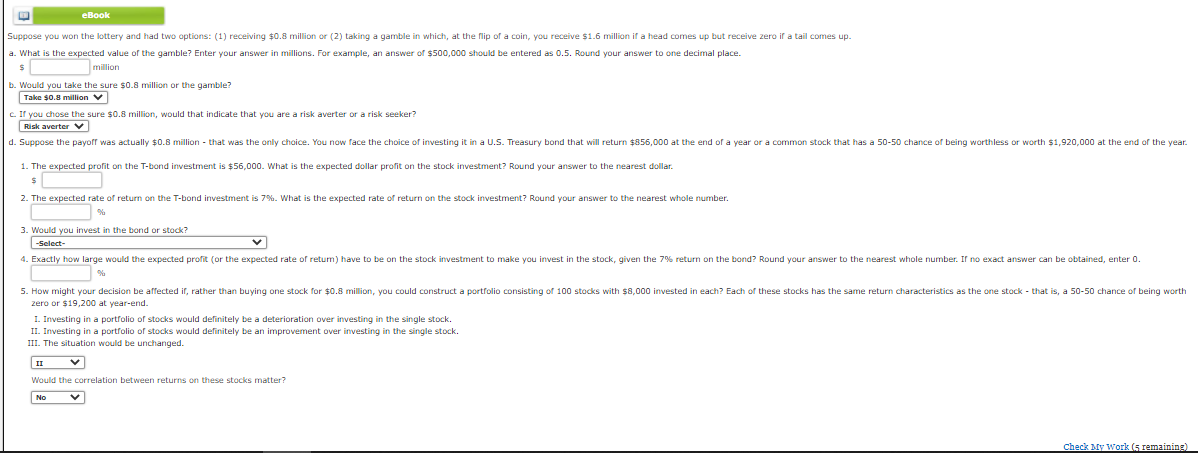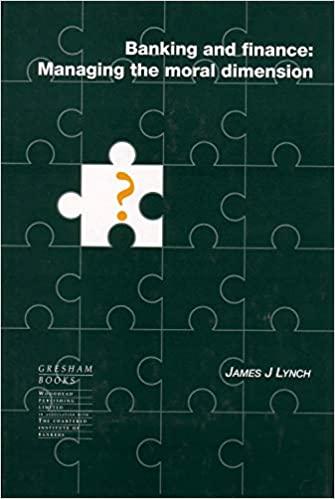Answered step by step
Verified Expert Solution
Question
1 Approved Answer
eBook Suppose you won the lottery and had two options: (1) receiving $0.8 million or (2) taking a gamble in which, at the flip of

eBook Suppose you won the lottery and had two options: (1) receiving $0.8 million or (2) taking a gamble in which, at the flip of a coin, you receive $1.6 million if a head comes up but receive zero if a tail comes up. a. What is the expected value of the gamble? Enter your answer in millions. For example, an answer of $500,000 should be entered as 0.5. Round your answer to one decimal place. S million b. Would you take the sure $0.8 million or the gamble? Take $0.8 million If you chose the sure $0.8 million, would that indicate that you are a risk averter or a risk seeker? Risk averter d. Suppose the payoff was actually $0.8 million - that was the only choice. You now face the choice of investing it in a U.S. Treasury bond that will return $856,000 at the end of a year or a common stock that has a 50-50 chance of being worthless or worth $1,920,000 at the end of the year. 1. The expected profit on the T-bond investment is $56,000. What is the expected dollar profit on the stock investment? Round your answer to the nearest dollar. $ 2. The expected rate of return on the T-bond investment is 7%. What is the expected rate of return on the stock investment? Round your answer to the nearest whole number 3. Would you invest in the bond or stock? -Select- 4. Exactly how large would the expected profit (or the expected rate of retum) have to be on the stock investment to make you invest in the stock, given the 7% return on the bond? Round your answer to the nearest whole number. If no exact answer can be obtained, enter O. 5. How might your decision be affected if, rather than buying one stock for $0.8 million, you could construct a portfolio consisting of 100 stocks with $8,000 invested in each? Each of these stocks has the same return characteristics as the one stock - that is, a 50-50 chance of being worth zero or $19,200 at year-end. 1. Investing in a portfolio of stocks would definitely be a deterioration over investing in the single stock. II. Investing in a portfolio of stocks would definitely be an improvement over investing in the single stock. III. The situation would be unchanged. II Would the correlation between returns on these stocks matter? NO Check My Work (5 remaining) eBook Suppose you won the lottery and had two options: (1) receiving $0.8 million or (2) taking a gamble in which, at the flip of a coin, you receive $1.6 million if a head comes up but receive zero if a tail comes up. a. What is the expected value of the gamble? Enter your answer in millions. For example, an answer of $500,000 should be entered as 0.5. Round your answer to one decimal place. S million b. Would you take the sure $0.8 million or the gamble? Take $0.8 million If you chose the sure $0.8 million, would that indicate that you are a risk averter or a risk seeker? Risk averter d. Suppose the payoff was actually $0.8 million - that was the only choice. You now face the choice of investing it in a U.S. Treasury bond that will return $856,000 at the end of a year or a common stock that has a 50-50 chance of being worthless or worth $1,920,000 at the end of the year. 1. The expected profit on the T-bond investment is $56,000. What is the expected dollar profit on the stock investment? Round your answer to the nearest dollar. $ 2. The expected rate of return on the T-bond investment is 7%. What is the expected rate of return on the stock investment? Round your answer to the nearest whole number 3. Would you invest in the bond or stock? -Select- 4. Exactly how large would the expected profit (or the expected rate of retum) have to be on the stock investment to make you invest in the stock, given the 7% return on the bond? Round your answer to the nearest whole number. If no exact answer can be obtained, enter O. 5. How might your decision be affected if, rather than buying one stock for $0.8 million, you could construct a portfolio consisting of 100 stocks with $8,000 invested in each? Each of these stocks has the same return characteristics as the one stock - that is, a 50-50 chance of being worth zero or $19,200 at year-end. 1. Investing in a portfolio of stocks would definitely be a deterioration over investing in the single stock. II. Investing in a portfolio of stocks would definitely be an improvement over investing in the single stock. III. The situation would be unchanged. II Would the correlation between returns on these stocks matter? NO Check My Work (5 remaining)
Step by Step Solution
There are 3 Steps involved in it
Step: 1

Get Instant Access to Expert-Tailored Solutions
See step-by-step solutions with expert insights and AI powered tools for academic success
Step: 2

Step: 3

Ace Your Homework with AI
Get the answers you need in no time with our AI-driven, step-by-step assistance
Get Started


